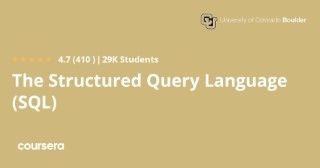The Structured Query Language (SQL)
Learn all about SQL, its origins, syntax, and how to use commands for data analysis in a relational database. Take the SQL course for academic credit as part of CU Boulder’s Master of Science in Data Science degree. Ideal for individuals with a broad range of undergraduate education and professional experience in computer science, information science, mathematics, and statistics. Enroll now!
In this course you will learn all about the Structured Query Language (“SQL”.) We will review the origins of the language and its conceptual foundations. But primarily, we will focus on learning all the standard SQL commands, their syntax, and how to use these commands to conduct analysis of the data within a relational database. Our scope includes not only the SELECT statement for retrieving data and creating analytical reports, but also includes the DDL (“Data Definition Language”) and DML (“Data Manipulation Language”) commands necessary to create and maintain database objects.
The Structured Query Language (SQL) can be taken for academic credit as part of CU Boulder’s Master of Science in Data Science (MS-DS) degree offered on the Coursera platform. The MS-DS is an interdisciplinary degree that brings together faculty from CU Boulder’s departments of Applied Mathematics, Computer Science, Information Science, and others. With performance-based admissions and no application process, the MS-DS is ideal for individuals with a broad range of undergraduate education and/or professional experience in computer science, information science, mathematics, and statistics. Learn more about the MS-DS program at https://www.coursera.org/degrees/master-of-science-data-science-boulder.
What you will learn
Introduction to SQL – Structured Query Language
The origins of SQL, what it is and how it works.
The Basic SELECT Statement
The SELECT statement – retrieving data from your database.
Group Functions, SubTotals, and Subqueries
The five GROUP functions.
Getting Data from Multiple Tables
Using the JOIN.
User Reviews
Be the first to review “The Structured Query Language (SQL)”
You must be logged in to post a review.







There are no reviews yet.